High level takeaways from the 2nd Annual Morgan Stanley Space Summit
On December 11, 2019, the 2nd Annual Morgan Stanley Space Summit in New York was in session — this event included participation from a range of private and public space companies, regulators and investors, with discussions centered on national security, Earth Observation (EO), launch, broadband, as well as hypersonic transport.
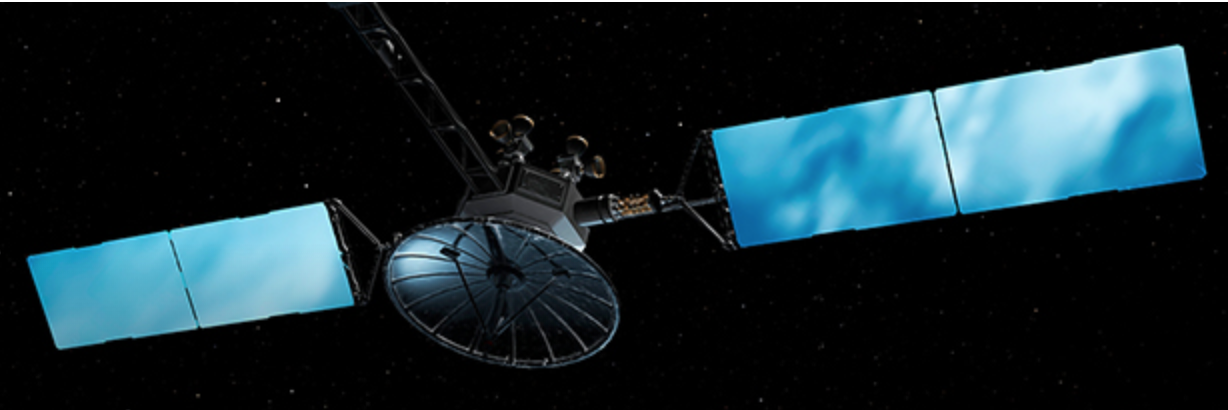
Here are Morgan Stanley’s high level takeaways from the event:
• Government involvement has increased, from the Department of Commerce to the military, with the FY20 NDAA establishing the Space Force as a separate military branch in the US. The House is expected to vote on December 11, 2019, with the Senate to consider at a later date.
• There is a greater emphasis on financial discipline in the industry, with a focus on developing the building blocks for space and sound business model fundamentals vs. “gas stations in space.”
• Private equity being priced a bit tighter? Private investment has continued to flow into the space industry through 2019, but challenges with respect to late stage financing may grow, as investors expect progress to be made by the end of 2020.
• As it relates to national security, the DoD/IC will remain a technological leader in various sub-segments of space, though demand for actionable intelligence will drive particularly high demand for analytics and the application of ML/AI going forward.
• Technological emphasis included: cyber, GPS, communications, data and analytics, SAR, propulsion, travel, space situational awareness/orbital debris mitigation.
• Investor interest is increasing... Total attendance for the summit was up over 100 percent YoY including investor attendance that tripled YoY.
Here are some key milestones and catalysts that Morgan Stanley expects to develop in the year ahead:
OneWeb & Starlink Launches
OneWeb plans to launch > 30 satellites per month in late 2020. Meanwhile, SpaceX Founder Elon Musk has said that Starlink needs 400 satellites to have continual coverage of limited geographies, and 1,000 satellites to be economically viable.
GEO Mobility Focus
Opportunities: Both ViaSat and Intelsat noted areas like inflight connectivity and maritime as growth drivers moving forward. ViaSat remains on track to launch its first ViaSat-3 satellite in 1H21 with a direct insertion launch.
Space Travel
Virgin Galactic plans to start commercial flights in mid 2020, while Blue Origin is planning crewed flights on the New Shepard.
NASA Commercial Crew Program Boeing is planning an uncrewed Orbital Flight Test on December 19, 2019, with the CST-100 Starliner Crew Flight Test estimated for mid 2020. SpaceX is targeting no later than January 4, 2020 for an in-flight abort test of the Crew Dragon, with the Crew Dragon Demo 2 in 2020.
Space Force?
The House and Senate Armed Services Committees (HASC and SASC) completed the FY20 NDAA conference report earlier this week that recognizes space as a warfighting domain and establishes the U.S. Space Force. The legislation now heads to vote in Congress, with the expectation of passage and signing into law by the President later this month.
More Capital Market Events? CNBC has documented comments from the leadership at SpaceX, Blue Origin, Rocket Lab, and Spire, with regard to various companies’ plans to access capital or go public.
Arianespace successfully lifts multiple payloads to orbit
Arianespace successfully launched five satellites on the company’s year-ending Soyuz mission — departing at the exact planned liftoff moment of 5:54:20 a.m., local time.
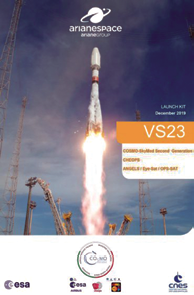
The Soyuz ST-A launcher version flew a four-hour-plus profile to release its multi-satellite payload into SSO – starting with primary passenger COSMO-SkyMed Second Generation, then CHEOPS (Characterizing Exoplanet Satellite) and three auxiliary payloads: EyeSat, OPS-SAT and ANGELS.
To read the Soyuz technical overview by Arianespace, please access www.arianespace.com/vehicle/soyuz/#
This morning launch marked the Russian-built vehicle’s 23rd liftoff from the Spaceport in French Guiana and the 49th Soyuz mission overall for Arianespace (including 26 originating from Baikonur Cosmodrome in Kazakhstan, performed by the company’s Starsem affiliate). It provided an estimated total lift performance of 3,250 kg., including the satellites and ASAP-S multi-passenger dispenser system.
COSMO-SkyMed 2Gen
To be used for Earth Observation (EO), COSMO-SkyMed Second Generation is the fourth satellite launched by Arianespace for the Italian Space Agency (ISA) and Ministry of Defence. The satellite was produced by Thales Alenia Space based on the manufacturer’s PRISMA platform and will deliver global coverage with a 16-day repeat cycle.
The full system of COSMO-SkyMed Second Generation satellites – developed to address the requirements of both commercial and government customers, as well as the scientific community – is designed to set new performance standards for space-based radar observation systems in terms of precision, image quality and the flexibility of user services.
COSMO-SkyMed Second Generation satellites, including the primary passenger orbited on this mission success with Soyuz, are equipped with synthetic aperture radars (SAR), allowing them to make observations under any weather or light conditions, both day and night.
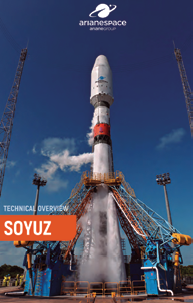
This second-generation system, including its ground segment, will set a new performance standard for space-based radar observation systems in terms of precision, image quality and the flexibility of user services. It is a dual (civil/military) system, designed to address the requirements of both commercial and government customers, as well as the scientific community.
COSMO-SkyMed Second Generation will be the 162nd satellite manufactured by this constructor to be launched by Arianespace. There currently are five Thales Alenia Space’s satellites in Arianespace’s backlog.
CHEOPS
Produced by Airbus, the Characterizing Exoplanet Satellite (CHEOPS) will be used by the European Space Agency (ESA) on a mission to study bright, nearby stars that already are known to host exoplanets, in order to make high-precision observations of the planet’s size. It is the 74th satellite launched by Arianespace at the service of ESA.
CHEOPS will focus on planets in the super-Earth to Neptune size range, with its data enabling the bulk density of the planets to be derived – a first characterization step towards understanding these alien worlds.
This is an ESA mission implemented in partnership — in particular — with Switzerland. This 74th satellite to be launched by Arianespace for ESA will mark the 52nd mission conducted by the launch services provider at the service of this space agency.
The spacecraft will focus on planets in the super-Earth to Neptune size range, with its data enabling the bulk density of the planets to be derived – a first characterization step towards understanding these alien worlds.
This is the 25th scientific mission (and the 32nd satellite) to be launched by Arianespace.
Airbus in Spain is prime contractor for the mission, with the University of Bern being responsible for the telescope. Airbus led a consortium of 24 companies (seven From Spain) representing 11 European countries. The spacecraft was built in two years.
CHEOPS is the 128th Airbus satellite to be launched by Arianespace and there are currently 21 Airbus satellites in Arianespace’s backlog.

Artistic rendition of one of two,
secondgeneration Cosmo-SkyMed
radar reconnaissance satellites.
Image is courtesy of Thales
Alenia Space.
Smallsat Passengers
The three auxiliary passengers on this Soyuz mission, designated Flight VS23 in Arianespace’s numbering system, were orbited for the benefit of European institutions.
OPS-SAT
OPS-SAT is the world’s first free-for-use, on-orbit testbed for new software, applications and techniques in satellite control and brings Europe forward to a new era of space flight innovation and commercial opportunity. Its launch was performed for Tyvak Nano-Satellite Systems on behalf of ESA.
This a 3U CubeSat and the first satellite to be launched by Arianespace for Tyvak on behalf of ESA. Tyvak International of Italy provided the deployer and launch service for OPS-SAT on behalf of ESA. During the satellite’s first year of operation, OPS-SAT will host more than 100 in-flight experiments submitted from many ESA Member States. OPS-SAT was developed by the Graz University of Technology with subcontractors from Austria, Germany, Poland and Denmark. It will be operated by ESA from the European Space Operations Center (ESOC) in Germany.
EyeSat
EyeSat, a cubesat designed to study zodiacal light and image the Milky Way, is being financed and developed by the French CNES space agency within the scope of the Janus project, which is designed to encourage students in universities and engineering schools to develop their own very small satellites.
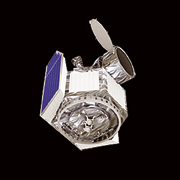
An artistic rendition of the
CHEOPS satellite. Image
is courtesy of ESA.
Jointly financed and developed by CNES and Hemeria, ANGELS (for: Argos Néo on a Generic Economical and Light Satellite) is the first smallsat produced by French industry and will collect and determine the position of low-power signals and messages sent by the 20,000 ARGOS beacons now in service worldwide. The satellite is fitted with an instrument called IRIS, which is a small space telescope.
EyeSat will be the 16th satellite (including Pleiades satellites) to be launched by Arianespace for CNES. There is one additional CNES satellite to be launched in the Arianespace’s backlog: TARANIS.
ANGELS
Argos Néo on a Generic Economical and Light Satellite (ANGELS) is jointly financed and developed by the French CNES space agency (Centre National d’Etudes Spatiales) and Hemeria – an innovative industrial group active in the aerospace, defense, energy, rail and automotive markets (which is an affiliate of Nexeya).
ANGELS is a 12U CubeSat, and is the French industry’s first smallsat. The satellite will be fitted with a miniaturized ARGOS Néo instrument, which is 10-times smaller than the equivalent previous-generation device.
The instrument collects and determines the position of low-power signals and messages sent by the 20,000 ARGOS beacons now in service worldwide.
There are two project teams – CNES and Hemeria for ANGELS; and CNES, Thales Alenia Space and Syrlinks for ARGOS Néo – and they worked together on this French space project. ANGELS is paving the way for French industry to build operational smallsats within the “new space” environment.
ANGELS will be the 17th satellite (including Pleiades satellites) to be launched by Arianespace for CNES.
Flight VS23 was Arianespace’s third launch in 2019 using a medium-lift Soyuz, and the ninth overall this year across its full family of launchers – which also includes the heavy-lift Ariane 5 and lightweight Vega.
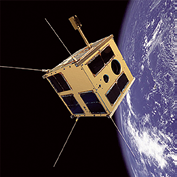
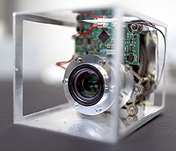
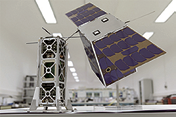
Arianespace CEO Stéphane Israël, who provided his post-flight comments from the Spaceport’s mission control center, said for the company’s ninth and last launch of the year, success is here for Arianespace’s customers and partners. This success shows Arianespace’s ability to deliver for European institutions and to orbit innovative small satellites.
www.arianespace.com
www.thalesgroup.com/en/global/activities/space
www.esa.int
www.airbus.com
www.tyvak.com
www.tugraz.at
cnes.fr
www.hemeria-group.com
Gilat’s In-Air ESA enjoys a successful demo on a commercial aircraft
Gilat Satellite Networks Ltd. (NASDAQ, TASE: GILT) has announced that Gilat’s In-Flight Connectivity (IFC) Electronically Steered Antenna (ESA) is the first-ever to operate during flight on a commercial aircraft — this well positions Gilat to win the vast opportunities in the fast changing market of ESA.
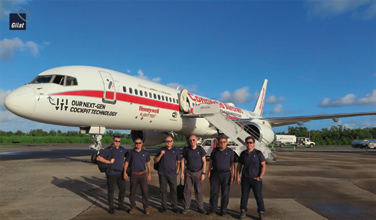
Gilat’s ESA terminal achieves industry milestone. Photo is courtesy
of the company. 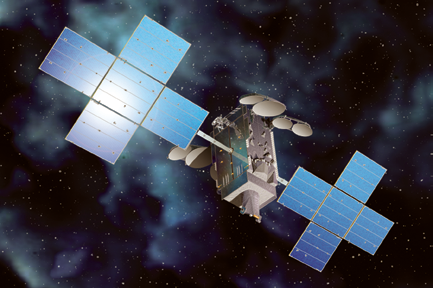
Artistic rendition of the Telstar 19 VANTAGE HTS satellite.
Image is courtesy of Telesat.
The industry milestone was achieved onboard Honeywell’s Boeing 757 test aircraft with Gilat’s ESA terminal operating over Ka-band capacity on Telesat’s Telstar 19 VANTAGE High Throughput Satellite (HTS).
Gilat’s high throughput antenna demonstrated remarkable scores with complete gate-to-gate operation. Gilat’s ESA has no moving parts, full electronic beam steering and a flat panel with an extremely low profile.
Gilat’s innovative design combines the benefits of ESA with the advantages of Ka-band, as highlighted by the performance achieved in
this testing.

The ESA terminal can serve both GEO and NGSO constellations that operate in Ka-band and features Gilat’s industry leading aero modem.
Kevin Calcagni, CTO at Honeywell Connected Enterprise, Aerospace, said the company sees the electronically steered antenna as a key future technology and this test is an important milestone showcasing its potential. Honeywell has been investing in this technology for several years, and in parallel look to industry partners to innovate with the company. The firm is pleased to successfully collaborate with Gilat in this pilot that again demonstrates Honeywell’s leadership position in the connectivity market.
Michel Forest, Director of Systems Engineering for the LEO Program at Telesat, noted that the company is pleased to join forces with longtime partner, Gilat, in achieving an additional remarkable milestone, this time using Gilat’s ESA antenna over Ka-band capacity on Telesat’s Telstar 19 VANTAGE GEO HTS. Gilat’s ESA innovations demonstrate the ability to access and unleash the throughput and performance of Ka-band HTS beams with a low-profile antenna as desired by airlines.
Liran Wiener, Director of SatCom On-the-Move Programs at Gilat, added that the accomplishment of the successful in-flight demonstration of Gilat’s IFC ESA terminal onboard Honeywell’s commercial jetliner using Ka-band capacity on Telesat’s Telstar 19 VANTAGE HTS demonstrates the company’s innovation and progress for next-generation IFC ESA technology as well as the firm’s ability to overcome massive technological challenges. This exciting solution meets the communication needs of the aero market including both commercial and smaller jets that until now could not be served efficiently by existing solutions and opens up great opportunity for Gilat over GEO satellites and Non-GEO constellations.
Brought to fruition... Telespazio’s new control room at the Fucino Space Center
Leonardo, through its subsidiary Telespazio, has debuted their new LEOP (Launch and Early Orbit Phase) control room at the Fucino Space Center in Abruzzo, Italy, the technological core for the sensitive satellite orbital insertion and testing the activities.
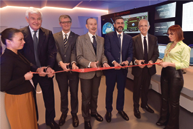
The ceremony was attended by the Undersecretary of State of the Prime Minister’s Office with delegation for Space, Riccardo Fraccaro, the Military Adviser of the Presidency of the Council, Admiral Carlo Massagli , the President of the Italian Space Agency, Giorgio Saccoccia, the CEO of Leonardo, Alessandro Profumo, and the Coordinator of Leonardo Space Activities and CEO of Telespazio, Luigi Pasquali.
The order of complexity that is managed during a LEOP activity includes up to 50,000 telemetric parameters indicating the satellite status, with a required performance during this type of operation very close to “zero error tolerance.”
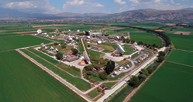
Aerial view of Telespazio’s Fucino,
Italy, Space Center. Photo is courtesy
of the company.
The role of Leonardo in COSMO-SkyMed Second Generation is not limited to the already completed orbital insertion of the satellite. The company, in fact, also provides stellar attitude sensors for correct positioning in space, while the power required for satellite and instrument operation is guaranteed by eight, advanced, photovoltaic panels.
Multiple control and distribution units will transform sunlight into power and will manage it, maximizing its efficiency to power on-board systems and subsystems. After COSMO-SkyMed, the “Piero Fanti” Centre will supervise the launch of the EUMETSAT European meteorological satellites in 2021.
The “Piero Fanti” Fucino Space Center extends more than 370,000 sq. m. and operates 170 antennas. In addition ti the LEOP room, the center has rooms dedicated to controlling the network of ground stations and flight dynamics, equally important activities in the management of a satellite mission. All facilities are manned 24 hours a day and can simultaneously handle multiple space missions.
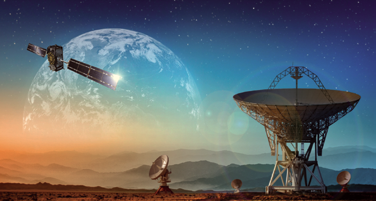
Alessandro Profumo, the CEO of Leonardo, stated that the continuous investment in technologies, capabilities and infrastructures to guarantee safe and effective space operations, in view of the strong growth of the sector, is an indispensable factor to consolidate the leadership of Leonardo in satellite services. Leonardo, through Telespazio, is the only private operator in Europe capable of managing the LEOP stage of a satellite mission. The firm is among the most innovative companies in the marketing of services for institutions, businesses and citizens, from navigation to geo-information, to the security of territories and infrastructures.
Luigi Pasquali, Coordinator of Leonardo Space Activities, added that since 1996 to the present day, Telespazio has successfully carried out more than 50 operations to put into orbit some of the most important international satellites, many of them with Leonardo technologies on board. The new room will also represent a strategic asset for electric propulsion LEOPs, which will become increasingly important in the coming years.
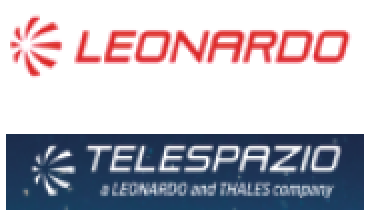
The most important stages characterizing a LEOP phase are:
1 - First telemetry acquisition through the antennas of the Ground Station network after launcher separation.
2 - Initialization and configuration of the propulsion system.
3 - Positioning toward the sun and unfolding of solar panels to allow the supply and recharge of internal batteries.
4 - The various (3 to 5) Apogee maneuvers to pass from the release orbit, highly elliptical and inclined with respect to the Equator, to the geostationary one at an altitude of 42,168 km. from the center of the Earth, which has the characteristic of having the same period of the Earth revolution (24 hours).
5 - Reaching the target longitude and entering the nominal mode, with the communications antennas facing the ground, the panels fully open and all the subsystems active.


